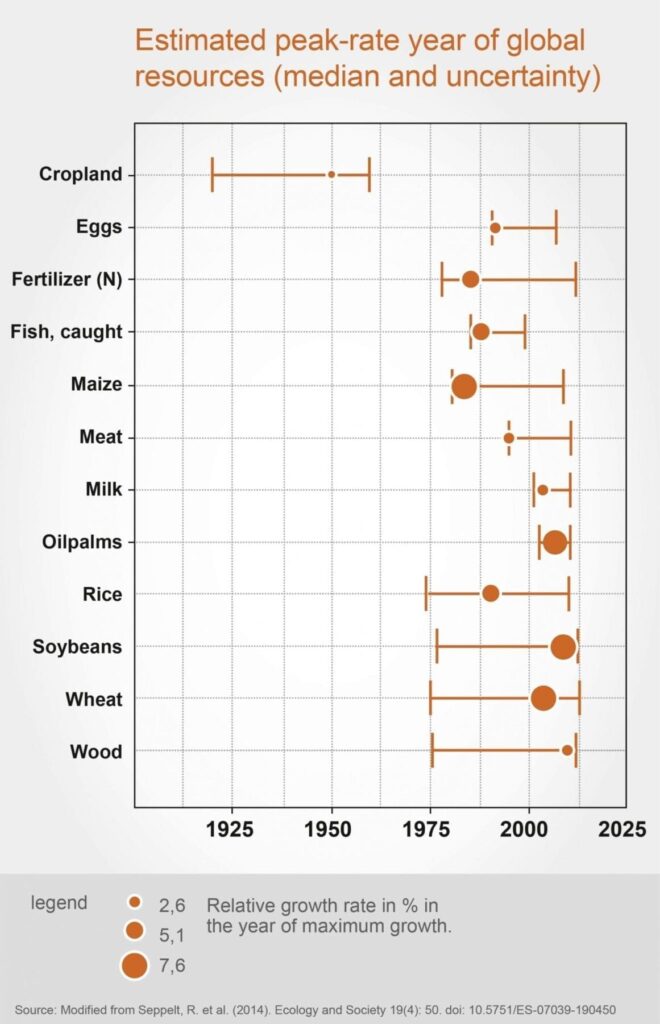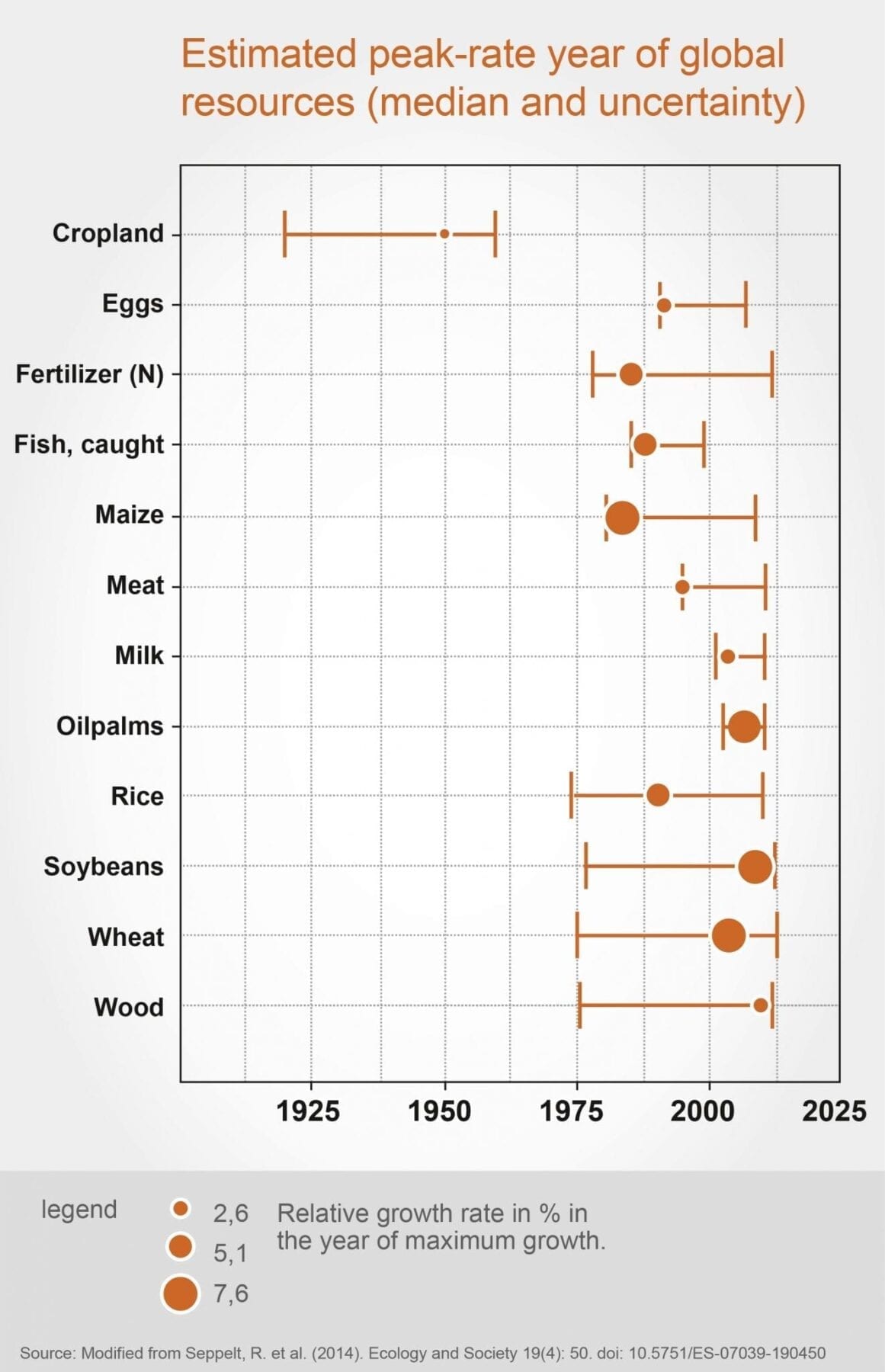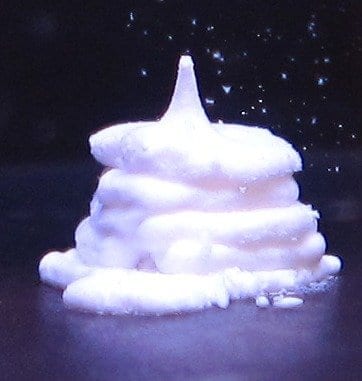
Humanity should use planetary resources with care
Can the world continue expanding its use of renewable resources at an increasing rate? Most likely not. Using a data set of over 25 resources researchers at the Helmholtz Centre for Environmental Research (UFZ), Yale University and Michigan State University demonstrate that several key resources have recently passed, at around the same time, their “peak-rate year” — the maximum increase year. A potential implication is that as substitution becomes arduous, global society’s expanding needs will be harder to fill. They explain this in an article published in the latest issue of the international journal Ecology and Society, and featured in the journal Nature’s Research Highlights this week.
Landscape ecologists Prof. Dr. Ralf Seppelt, Dr. Ameur M. Manceur and plant ecologist Dr. Stefan Klotz from the UFZ analysed the production and extraction rates of 27 global renewable and non-renewable resources together with economist Dr. Eli Fenichel from Yale University and sustainability scholar Dr. Jianguo Liu from Michigan State University. They examined 20 renewable resources, such as maize, rice, wheat or soya, which represent around 45% of the global calorie intake according to the Food and Agriculture Organisation of the United Nations (FAO of the UN), as well as animal products, such as fish, meat, milk and egg. For 18 of these renewable resources the annual growth rate (for example the increase in meat production or in fish catch) reached its peak — the peak-rate year — around 2006 a few years ago.
The term peak in the context of resource use is not new as it was popularized in the discussion about peak oil initiated in the mid-1970s. The peak oil analysis of the mid 1970s alleged that the crude oil extraction rate would significantly decline after a given year. Whether such a decline will happen and what would be the ultimate cause has been hotly debated among scientists. Though oil production has actually continued to expand, other resources have followed such a pattern. UFZ researchers used a dataset of more than 25 resources and made limited assumptions, relying on computer power to extract pattern from the database. “For many resources, but not oil, we indeed observed a peak pattern”, states Dr. Seppelt.
Surprisingly, they discovered not only that 20 resources had a peak-year but also that for 16 of the 20 resources with a peak-year, the peak-year lay between 1988 and 2008 — a very narrow range in the history of humanity! “The key commodities that a person needs for food and must harvest are limited”, summarizes Dr. Seppelt, Head of the Landscape Ecology Department at the UFZ. Renewable resources become scarcer. The authors were able to illustrate this using a various examples: The maximum global growth rate in crop yields for soya beans was in 2009, for milk it was 2004, for eggs it was 1993 and for the fish caught it was 1988. Data from other studies confirm these results. For example, the crop yield per area with maize, wheat, soya and rice on more than a quarter of the farming area around the world is stagnating or decreasing according to the US scientists.
Read more: Renewable resources reach their limits
The Latest on: Reneweable planetary resources
[google_news title=”” keyword=”Reneweable planetary resources” num_posts=”10″ blurb_length=”0″ show_thumb=”left”]
via Google News
The Latest on: Reneweable planetary resources
- Should Harming the Planet Be a Crime? The Case for Ecocide Lawson May 1, 2024 at 10:48 pm
On December 3, 2019, the Pacific island state of Vanuatu made an audacious proposal: Make ecocide—the destruction of nature—an international crime. “An ...
- Earth Day, Climate Change, and Human Healthon May 1, 2024 at 9:00 pm
Earth Day provided a good moment to reflect on the climate, climate change, and, most importantly, how the climate directly impacts human health.
- Your Ecological House: Looking at the phases of disruptionon April 27, 2024 at 11:04 am
The results, in terms of increased pollution and resource depletion, are adding up quickly, and, if left unchecked, could render much of the earth uninhabitable — probably within the next few decades.
- Solar geoengineering to cool the planet: Is it worth the risks?on April 25, 2024 at 8:53 am
When I first wrote about geoengineering in 2012 , it was considered far-fetched at best, and crazy by most. But 12 years later, while there is still controversy and considerable resistance to ...
- Climate Policy Is Workingon April 24, 2024 at 7:50 am
KELLY SIMS GALLAGHER is Professor of Energy and Environmental Policy and Interim Dean of the Fletcher School at Tufts University. These young people despaired of attempts by their governments to ...
- Earth Day 2024 report card: Experts address America's climate change actionon April 23, 2024 at 1:31 pm
As the effects of climate change come knocking at American doors, experts say U.S. lawmakers can no longer rely on crisis response measures and must take action.
- Opinion: Environmental sustainability and consumptionon April 22, 2024 at 11:32 am
One of the politically destructive strands of environmental advocacy criticizes material consumption and attempts to make people feel guilty for air travel and other forms of behavior that pollutes ...
- This Earth Day, it doesn’t have to be ‘Mother Nature versus Man’on April 22, 2024 at 5:00 am
And while we continue avoiding another stone age by exploring space and creating new technologies, we should respect and learn from nature.
- New scientific interventions are here to fight climate change. But they aren’t silver bulletson April 22, 2024 at 3:00 am
Giant sun shades, 40-foot-tall air filters, stratospheric sulfur injections: Here are some of the wild and wondrous ways we might save the planet.
- Taking the good with the bad on Earth Dayon April 20, 2024 at 8:30 am
Every Earth Day, which began in 1970 and is observed on April 22, we are bombarded with messages about the state of the planet, what humans are doing to it, and how we can be better stewards of the ...
via Bing News











